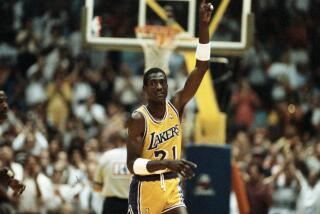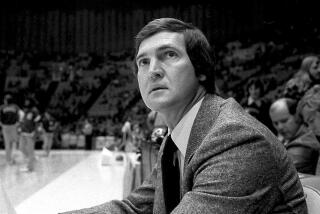They’re Vintage Triple-Doubles
- Share via
Forty years ago, Oscar Robertson put together a season unique in NBA history.
You want numbers? Peep the Big O’s stats from 1961-62: 30.8 points, 12.5 rebounds, 11.4 assists a game.
That’s right, he averaged a triple-double.
“I think that’s still the most unbelievable thing I’ve heard of, along with Wilt’s 100 points,” Magic Johnson said.
You hear triple-double, you probably think of Magic. That’s kind of like Elvis Presley and rock ‘n’ roll; he’s the guy who popularized it, not the one who originated the style.
Johnson produced 138 triple-doubles in his career. They call him the NBA’s all-time leader. Like “blocked shots,” which were not kept as official statistics until 1973-74--after Bill Russell and Wilt Chamberlain’s years of controlling the paint--the triple-double is a category that will always be skewed.
The term “triple-double” was coined by Bruce Jolesch, the former Laker public relations director who needed a way to summarize Johnson’s penchant for recording double figures in points, rebounds and assists.
If they’d bothered to keep track back when Oscar played, he would have put the number off the charts. He was just three-tenths of an assist here, one-tenth of a rebound there from averaging a triple-double in each of his first four seasons.
In his rookie year with the Cincinnati Royals in 1960-61, he averaged 30.5 points, 10.1 rebounds and 9.7 assists. In 1962-63, he averaged 28.3 points 10.4 rebounds and 9.5 assists. In 1963-64: 31.4 points, 9.9 rebounds and 11 assists. When you add up the numbers and divide them over his 309 games, Robertson’s averages for his first four seasons come out to 30.2 points, 10.7 rebounds and 10.4 assists.
To Robertson, it was just about playing basketball, not posting numbers.
“I thought everybody played the same way,” Robertson said. “I was just trying to win. You did what you could to win. We didn’t have a great basketball team, didn’t have great forwards.”
That’s where his emphasis on rebounding came in. And considering some of the centers he had to fight to get those boards, it’s what he considers the most impressive about his triple-doubles.
“When I [started playing in the NBA], they only had eight basketball teams,” Robertson said. “You had Russell, Chamberlain--Nate Thurmond came on later--really great inside presence on rebounds. I think my feat was special, looking back on it.”
The assists came from reading the game.
“As a guard, you try to probe,” Robertson said. “If you play against someone and your man has got a mismatch, you keep going to it. When I played, you kept going to someone till he missed.”
And while handling all the little things, he still finished among the top three scorers in the league in each of his first seven seasons.
“When I played, I’m averaging 30 points per game, as well as the assists and rebounds,” Robertson said. “Today if they get 10 points, they think it’s the coming of Jesus. If I’d averaged 10 points and 10 assists and rebounds, they wouldn’t have said much about it.”
New Jersey Net guard Jason Kidd is a leading candidate for most valuable player, in part because he led the NBA in triple-doubles.
He had eight.
“When you think about it--a triple-double every night,” Johnson marveled. “My little ones that I accomplished were hard enough. It’s just amazing. I don’t think he gets enough credit for that.”
Those who played against him know better. Mentioning Robertson’s name at the gathering of Minneapolis and L.A. Laker greats last week set the praise flowing.
“Oscar amazed me every time he played,” said Clyde Lovellette. “Because he was a great ballplayer. You can’t mention any guard without mentioning Oscar, because he was a super player.
“I don’t know about the double-doubles and the triple-triples, but he came to play every game,” Lovellette added. “He was on the court 40 minutes, 48 minutes, and he’d give you 100% all the time. He was just a great individual, great ballplayer. He’d rank right up among the top players today at his position.”
At 6 feet 5, Robertson redefined the guard position. Without him, you wouldn’t have 6-9 guys like Johnson bringing the ball up, or guards operating in the low post. (Another thing they had in common: both won championships with Kareem Abdul-Jabbar. Robertson got his in Milwaukee in 1970-71).
Although he was Johnson’s forerunner, “They didn’t play the game at all alike,” said Jerry West, the former Laker guard and later executive vice president.
“[Johnson] played the game with a flair, a completely different kind of game. Oscar looked more methodical. He just ground people down. He had a great instinct to do the kind of things that made him great.
“He was just a great player. He could do everything. He really didn’t have any weaknesses in his game. When he was born, they sprinkled some extra dust on him.”
In today’s players, Robertson sees some elements of his style in Kidd and Kobe Bryant.
Among the rest, however ...
“Some of these players seem like they’ve never touched a basketball,” he said. “Coming down, taking a long jump shot every time is not playing basketball.”
The man who set the NBA assists record--surpassed by Johnson and then John Stockton--can still dish out opinions on any number of topics.
He thinks that college athletes would get into less trouble if they had to stay on campus, that the NFL does a better job than any other sport when it comes to honoring its past heroes, that athletic shoe companies should market to more people than those 18-24, and that corporate America is too skewed toward the big companies.
That last opinion was ventured while discussing the chemical, sanitation management and corrugated packaging companies he runs.
Robertson, 63, still attends games at Cincinnati, where he was a three-time national college player of the year and led the Bearcats to the Final Four twice.
He’ll tune in to watch a few NBA teams on television.
“I like the Lakers, Sacramento, San Antonio,” Robertson said. “I like to watch Minnesota sometimes. Some teams I don’t want to watch, they’re not worth mentioning. I don’t think they’re very competitive. The organizations have not done a good job selecting [players].”
Robertson’s philosophy is that the game is won from the free-throw line and below. He said the Detroit Pistons understand the concept, which is why they’re winning, even though they don’t have any “star” players besides Jerry Stackhouse.
Forty years after Robertson’s landmark achievement, there were 29 triple-doubles posted this season. In 1961-62, that was just an average couple of months for Robertson.
Although, when you think about it, there was nothing average about it.
*
J.A. Adande can be reached at j.a.adande@latimes.com.
*
(BEGIN TEXT OF INFOBOX)
*--* Doubling Up When Oscar Robertson, right, joined the Cincinnati Royals in 1960, the term “triple-double” wasn’t in use in the NBA. Robertson was ahead of his time: through his first four pro seasons he was averaging a triple-double: Points Rebounds Assists Season Per Game Per Game Per Game 1960-61 30.5 10.1 9.7 1961-62 30.8 12.5 11.4 1962-63 28.3 10.4 9.5 1963-64 31.4 9.9 11.0 Totals 30.2 10.7 10.4
*--*
More to Read
Go beyond the scoreboard
Get the latest on L.A.'s teams in the daily Sports Report newsletter.
You may occasionally receive promotional content from the Los Angeles Times.










